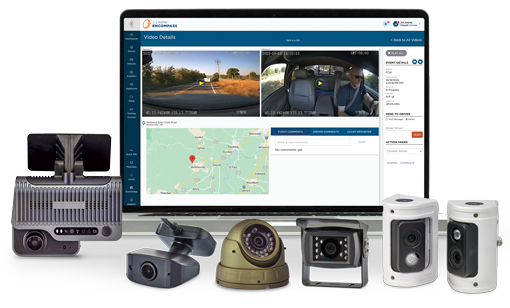Sr. Transportation Management Editor — J. J. Keller & Associates, Inc.
5 Fleet Dash Cam Myths
Those who haven't yet invested in dash cams are missing out on significant risk and operational benefits. Here are 5 myths about dash cameras.
Published On: 03/15/2024


Written by:
Mark Schedler
Dash cam use among commercial and business fleets is exploding, and those who haven't yet invested in this cab technology are missing out on significant risk reduction and operational benefits. If you're one of the fleets still on the dash cam sidelines, consider these myths cited frequently.
Myth #1: If I get dash cams, my drivers will quit.
A 2019 co-sponsored FreightWaves/J. J. Keller survey (1) reported that among fleets with dash cameras, 74% said that turnover has stayed the same or improved, while the remainder experienced a minimal or insignificant increase relative to industry norms. Many drivers now see dash cameras as protection against frivolous lawsuits and proof that they are doing their job. Pairing dash cam use with clean and concise policies and procedures, driver coaching, training and reward programs, carriers create an effective countermeasure to driver attrition.
To convince drivers to accept dash cameras requires a significant effort into communicating the ‘why’ of dash cams. The message is, “we want to improve skills and protect our drivers and the company from a wrongful lawsuit.”
Myth #2: Insurance will cover the cost if we have an accident.
The FMCSA regulations and individual state laws require insurance. Interstate for-hire operations of any property-carrying commercial motor vehicle must have $750,000.00 minimum coverage. Hazardous materials carriers are required to carry a $5,000,000.00 minimum. Unfortunately, carriers could find themselves in the red if they merely adhere to the federal minimum levels for liability coverage, as those minimums have not kept up in the era of nuclear verdicts.
Transportation providers should assess their actual exposure to risk, as it’s not uncommon for multi-million dollar lawsuit awards. Organizations have to provide for the amount their insurance provider does not cover. Smaller operations are at greater risk of losing everything in litigation.
Forty-nine percent of survey respondents who had installed dash cams stated they had seen a decrease in the average value of insurance claims. Sixty-one percent said they had seen a decline in the number of insurance claims.
Myth #3: Dash cams could hurt me in court if my driver is at fault for an accident.
False. Even if your driver is in the wrong, the dash cam footage provides indisputable evidence so you and your lawyers can work toward a quick settlement. Dash cams also often help reduce the insurance claims process time because video evidence helps investigators quickly determine fault, which results in lower costs, demonstrating once again that time is money.
American Transportation Research Institute (ATRI) released the study "Issues and opportunities with driver-facing cameras" in April 2023. The study found that legal experts estimated:
- Driver-facing camera footage helps exonerate drivers in 49 percent of cases, and
- Road-facing camera footage helps exonerate the driver (and carrier) approximately 63 percent of the time.
Dean Croke, FreightWaves’ Chief Insights Officer, stated, “When a claim is underway, lack of evidence is one of the biggest issues underwriters face.” Croke, who spent several years leading an insurance provider shared that, “One of the things we always credited companies with was having technology that could help exonerate them in the event of an accident.”
Survey results showed that 45% of fleets with dash cameras identified lower legal fees and risks of litigation as a benefit.
Myth #4: The cost of cameras is too high, and the ROI takes too long to secure.
This is simply not the case. It's no secret that fleets run on small operating budgets and margins. However, dash camera costs have come down substantially over the last few years while innovation and technology capabilities have drastically improved, ensuring that most fleets see a return on investment in less than a year. The ROI is immediate if they have an accident and their driver is exonerated.
Additionally, carriers and organizations that coach drivers against observed risky behaviors can reduce cell phone use and distracted driving in a few days! Dash cams help uncover everything from failure to use a seatbelt to distracted driving, following too closely and hard braking — allowing carriers to address and effectively reduce the risk of future accidents. These efforts reduce violations, accidents, and CSA BASIC scores.
Fleets even offer monetary rewards to reinforce proper driving behaviors, using dash cam metrics to generate healthy competition among drivers. Turning learning into a game provides drivers with a quantitative and measurable sense of achievement, encourages training and focus on the tasks at hand, and delivers an engaging learning experience.
Don’t forget that you can also use dash cam footage as part of the Crash Preventability Determination Program to remove a non-preventable crash from the Compliance, Safety, Accountability (CSA) calculations used to create your Crash Indicator BASIC score.
Myth #5: There are too many rules for mounting hardware, and installations are complex.
Not the case. Federal Motor Carrier Safety Association (FMCSA) revised rules in May 2022 to give drivers and carriers more flexibility in mounting their tech hardware on the interior of their windshields. Now, dash cameras, GPS devices, and other safety technologies can be mounted up to 8.5 inches below the upper edge of the area swept by the windshield wipers or up to 7 inches above the lower edge. The FMCSA also expanded the definition of “vehicle safety technology” in §393.5 to include almost any “system” or “item of equipment” that uses cameras, lidar, radar, sensors, and/or video to promote driver, occupant, or roadway safety.
As for installation, most systems, like the J. J. Keller® Dash Cam PRO, install into the vehicle’s diagnostic port, like an electronic logging device (ELD). Once connected to the back office (typically via cellular connection), video is sent to the video event dashboard, and risky driving is captured.
Don’t wait to take advantage of the benefits of dash cameras. Talk with a J. J. Keller compliance specialist today to learn about special offers on in-cab hardware, like the Dash Cam PRO. Call 855.693.5338 or visit JJKeller.com.
1) Leveraging the Benefits of Dash Cam Technology, written by Freightwaves & J. J. Keller & Associates, Inc, 2019.
You may also enjoy the following articles:
Sign up for our newsletter!
We'll help you stay on top of regulations, best practices, and fleet industry news. Sign up to receive a monthly email notification with links to our most recent blog articles, free resources, and event invites.
